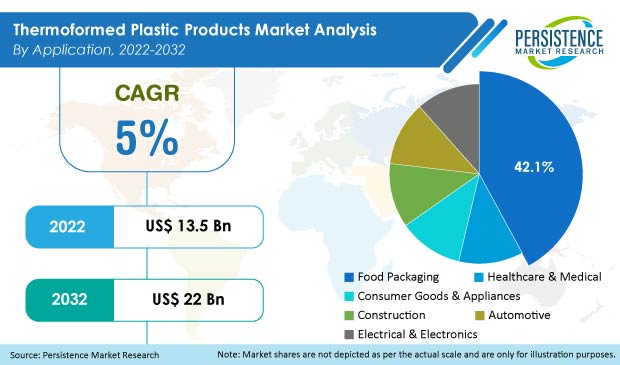Thermoformed Plastic Products Market Segmented By Synthetic and Biodegradable in Packaging, Food Serving Articles
Industry: Chemicals and Materials
Published Date: October-2016
Format: PPT*, PDF, EXCEL
Delivery Timelines: Contact Sales
Number of Pages: 135
Report ID: PMRREP12025
Thermoforming is a process of producing plastic products wherein a thermoplastic sheet of a particular size is clamped in place, heated to a softening temperature, and forced against a mold with the help of air, vacuum pressure, or mechanical means. Thermoformed plastic products are mainly used in food and beverages, medical, aerospace and aviation, business machines and equipment, building and construction, mass transit, and automotive industries. These products are divided into two types – synthetic and biodegradable.
Food and beverages (F&B) thermoformed plastic products find application in the packaging of products such as meat, bakery products, takeaway food products, dairy products, beverages, food articles, and others. Owing to advantages such as savings in cost and time, uniformity of end-product, and easy usage, thermoformed plastic products are gaining popularity among end users. The global F&B thermoformed plastic products market is estimated to be valued at US$ 11.2 Bn by the end of 2016, registering a CAGR of 4.2% over the forecast period (2016–2024).
The cost of thermoforming plastic products is nearly 10-15% less as compared to plastic products manufactured from injection molding. In addition, in thermoforming plastics, there is a lot of flexibility and scope to provide a wide range of presentation possibilities that help manufacturers package and brand their products attractively.
These are the main reasons leading to an increasing adoption of thermoformed plastic products as compared to traditionally packaged products. In addition, lifestyles are changing globally and due to increased urbanization and a rise in the number of working people, consumers prefer to spend less time in preparing meals and prefer convenience food or pre-prepared meals.
Also, there is an increasing demand for packaged mineral water, packaged milk, and packaged carbonated drinks and fruit juices. There is a noticeable shift in consumer preferences from unpacked food to packed food. This factor is also contributing significantly to the increased usage of thermoformed plastic products.
Besides, the growing retail sector in the form of supermarkets, convenience stores, and hypermarkets and growing consumer awareness regarding food safety are also leading to increased adoption and boosting the growth of the global F&B thermoformed plastic products market worldwide.
However, growing concerns about the recycling and disposal of plastic packaging products and increasing environmental concerns have led to governments worldwide enforcing various regulations on the usage and disposal of plastic packaging products. These developments act as a major restraint to the growth of the global F&B thermoformed plastic products market over the forecast period.
In addition, during thermoforming, it is difficult to attain precise wall thickness symmetrically over the entire product, thereby affecting the quality of the product adversely. This technical difficulty leads to manufacturers looking for a substitute to thermoformed plastic packaging products, thereby acting as a restraint to the global F&B thermoformed plastic products market.
The global F&B thermoformed plastic products market is segmented on the basis of product type, application, and region. On the basis of product type, the market is segmented into synthetic and biodegradable segments.
The synthetic segment is estimated to account for 86.7% revenue share of the global F&B thermoformed plastic products market by the end of 2016 and is expected to remain the dominant segment during the forecast period. Owing to support from various government and environmental organizations, the biodegradable segment holds futuristic opportunities; however, high prices of biodegradable products is expected to remain a key challenge for the segment’s growth over the forecast period.
By application, the thermoformed plastic products market is segmented into packaging, food serving articles, and others. The packaging segment is estimated to hold more than two-thirds share in the global F&B thermoformed plastic products market by 2016 end.
The segment is further sub-segmented into meat packaging, bakery products, takeaway food products, dairy products, and beverages. Among sub-segments, the beverage sub-segment is estimated to account for 34.7% value share by 2016 end.

On the basis of region, the global F&B thermoformed plastic products market is segmented into North America, Latin America, Europe, Asia Pacific (APAC), and Middle East & Africa (MEA). Europe is estimated to hold 32.1% revenue share of the global thermoformed plastic products market by 2016 end.
High demand for convenience food due to a large working population is a key factor boosting demand for these products in Europe. The market in Asia Pacific – accounting for more than one-fourth of the total market share – is expected to witness a CAGR of 5.3% during the forecast period.
Key players in the global F&B thermoformed plastic products market include Clear Lam Packaging Inc., D&W FINE PACK, HUHTAMAKI GROUP, Placon, Anchor Packaging Inc., Berry Plastics Corporation, Reynolds, Silgan Holdings Inc., and Tray-Pak Corporation.
The global F&B thermoformed plastic products market is characterized by high fragmentation and manufacturers are adopting mergers and acquisitions as a strategy to increase their global presence and market penetration.
To know more about delivery timeline for this report Contact Sales
